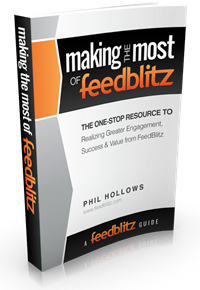 | ||
Making the Most of FeedBlitz: Understanding RSS Metrics
CirculationCirculation is the total number of unique people to whom your feed was available in the given time frame. This not only includes those who subscribe in a reader or via email; but also those who view your feed in their browsers. Consider a traditional print newspaper or magazine. Enough are printed for delivery to subscribers, but they print more to be bought at newsstands by casual readers. The total number of people who actually get the newspaper is subscribers + casual purchasers, and that's the circulation number. If you prefer to think in terms of an email list analog, the circulation is analogous to the number of emails sent when you broadcast a message to your list. ReachWhen you send an email to your list, you know that the number of people who actually open the email is going to be less than the number of people to whom it's sent. That's the mailing's open rate. "Reach" is the analogous "opens" metric for RSS feeds. It is the number of unique people who actually interacted with your feed in the specified time frame, whether by reading the post, or by clicking through on a link within the post. "Reach" de-duplicates multiple views and clicks by the same user on an item, so it will be typically be less than the sum of the number of clicks + the number of views. Reach can exceed your list's circulation, however, because reach can be amplified by social media promotion. If your post goes viral on Twitter, for example, it may be clicked into by hundreds or thousands of people. Each of those people will have a different signature that FeedBlitz will identify as a different unique user. When that happens, the reach total may well exceed the nominal circulation count, since a fetch by an aggregator for one Twitter account will contribute one to the circulation metric, not the number of followers that Twitter account has. If you want to include the number of followers in your site's audience calculation, use the FeedBlitz site dashboard for the relevant site. ViewsThe number of times an article was opened from the feed. ClicksThe number of clicks for an item in the feed. Since posts often contain more than one link, this number might be relatively large as people explore the links within an article. Like views, this is de-duplicated when deriving the day's reach metric. Platform DataFeedBlitz shows you the platform, or reader used, to consume the feed, and the number of people (the share of the circulation) which that platform accounts for. For most sites, the leading RSS reader is either Google Reader, or an email service like FeedBlitz. Which is a point worth emphasizing: For mailing lists powered by an RSS feed, the RSS feed's circulation count includes the number of email subscribers on the list. At the site dashboard level, FeedBlitz takes this fact into account when deriving the total audience figure where it can. FeedBlitz differentiates between three broad classes of RSS reader. These are explained below. RSS AggregatorsThese are apps and services that are used to fetch RSS feeds to be read later in a dedicated RSS reader, or for use in a pure RSS form – so this total can include machines polling your feed in order to convert it into a widget for your website, say. Services like Google Reader will check the feed on behalf of multiple users; FeedBlitz checks what the aggregator says it's doing to determine the correct circulation count due to that reader. There are individual desktop and mobile readers too; FeedBlitz will report those as well. If you specifically want to track the number of subscribers as opposed to the total circulation for any given day, use the RSS aggregator total alone. BrowsersWhen the user views your feed in their browser, it's a more casual interaction than a committed subscriber. It is, however, worth tracking and contributes to the circulation count. The totals for any given day are reported as the number of RSS visitors. Search EnginesYou'll find that your RSS feed is being visited by search engines – that's a Good Thing, and we report it here. Search engines, however, don't reflect someone actually visiting your feed; they are indexing it for inclusion in their search results. So although we track and report search engines in the RSS feed analytics, they do not contribute to your RSS feed's total circulation, any more than (say) Google indexing your online email archive represents someone being added to your email list.
More Blitz Bits
Get These Great e-Books from FeedBlitz
|
| Your requested content delivery powered by FeedBlitz, LLC, 9 Thoreau Way, Sudbury, MA 01776, USA. +1.978.776.9498 |



ليست هناك تعليقات:
إرسال تعليق